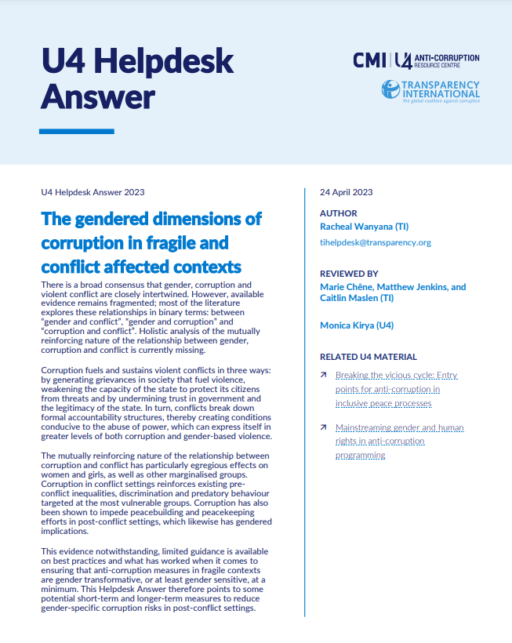- Home
- Anti-Corruption Helpdesk
- The gendered dimensions of corruption in fragile and conflict affected contexts
The gendered dimensions of corruption in fragile and conflict affected contexts

This Anti-Corruption Helpdesk brief was produced in response to a query from a U4 Partner Agency. The U4 Helpdesk is operated by Transparency International in collaboration with the U4 Anti-Corruption Resource Centre based at the Chr. Michelsen Institute.
Query
Please provide an overview of the gender-specific corruption risks at each stage of a conflict cycle; how does corruption affect men, women, LGBTQI+ and other marginalised groups differently in conflict and post-conflict contexts? What are the gendered dimensions of anti-corruption measures in post-conflict settings?
There is a broad consensus that gender, corruption and violent conflict are closely intertwined. However, available evidence remains fragmented; most of the literature explores these relationships in binary terms: between “gender and conflict”, “gender and corruption” and “corruption and conflict”. Holistic analysis of the mutually reinforcing nature of the relationship between gender, corruption and conflict is currently missing.
Corruption fuels and sustains violent conflicts in three ways: by generating grievances in society that fuel violence, weakening the capacity of the state to protect its citizens from threats and by undermining trust in government and the legitimacy of the state. In turn, conflicts break down formal accountability structures, thereby creating conditions conducive to the abuse of power, which can express itself in greater levels of both corruption and gender-based violence.
The mutually reinforcing nature of the relationship between corruption and conflict has particularly egregious effects on women and girls, as well as other marginalised groups. Corruption in conflict settings reinforces existing pre-conflict inequalities, discrimination and predatory behaviour targeted at the most vulnerable groups. Corruption has also been shown to impede peacebuilding and peacekeeping efforts in post-conflict settings, which likewise has gendered implications. This evidence notwithstanding, limited guidance is available on best practices and what has worked when it comes to ensuring that anti-corruption measures in fragile contexts are gender transformative, or at least gender sensitive, at a minimum. This Helpdesk Answer therefore points to some potential short-term and longer-term measures to reduce gender-specific corruption risks in post-conflict settings.
Contents
- Introduction
- Gender, corruption and conflict: establishing a link
- Gender-specific corruption risks across the conflict cycles
- Risks in pre-conflict settings
- Risks in time of war
- Risks during relief, recovery and reconstruction
- Addressing gender-specific risks in post conflict settings
- Principles for designing gender-responsive anti-corruption measures
- Measures for countering gender-specific risks of corruption in post-conflict settings
- Short-term measures
- Long-term measures
- References
Authors
Racheal Wanyana (TI)
Reviewed by:
Marie Chêne, Matthew Jenkins, and Caitlin Maslen (TI)
Monica Kirya (U4)
Date
26/04/2023

